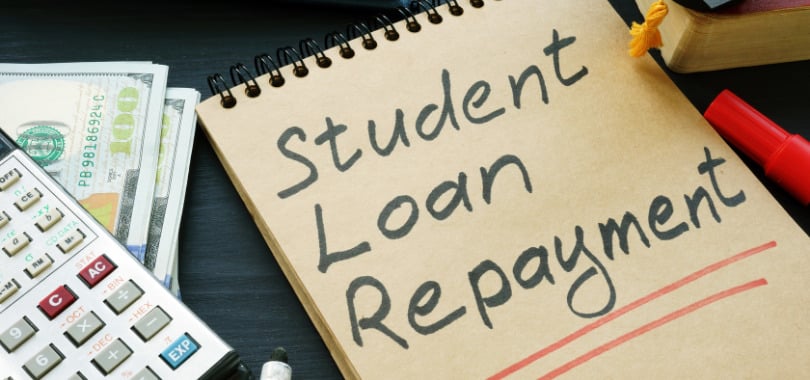When you take out student loans, they come with specified loan repayment terms. Federal student loans come with a standard 10-year repayment term. The repayment terms on private student loans may vary depending on the lender. The good news is you’re not stuck with these terms for the life of the loan.
Repayment options for your student loans may be different for federal and private student loans.
Federal Student Loan Repayment Options
There are four federal student loan repayment options that you can choose from. Each one has its own terms and pros and cons. The best option for you will depend on your financial circumstances as well as your long-term financial goals.
1. Standard Repayment Plan
This is a repayment plan with all federal student loans. The plan spreads the payments equally over 10 years. The principal and 10-year interest are calculated and divided into 120 equal installments (10 years x 12 months). The monthly payments remain fixed for the life of the loan.
- Pros: Your monthly interest remains the same every month for 10 years, making it easier to make a budget. You’ll save on interest.
- Cons: The monthly payments may be unaffordable if you’re earning a low income. You can’t take advantage of falling interest rates.
The standard repayment plan is best if you’re looking to minimize your interest accrual.

2. Graduated Repayment Plan
The graduated repayment plan also spans 10 years but there’s one major difference. With this plan, your monthly payments are low for the first two years. The payments then increase regularly every two years for a total of 10 years.
- Pros: The lower payments are more affordable when you’re just starting out so there’s a lower risk of defaulting on your loans.
- Cons: You’ll pay slightly higher interest over the life of the loan as compared to the standard repayment term.
The graduated extended repayment plan is a good option if you need your limited funds to cover other essential expenses. You can then pay more towards your loan repayments as your monthly income increases.
3. Extended Repayment Plan
This plan extends your repayment term to 25 years, which effectively lowers your monthly payments. You have two options within this plan – fixed or graduated payments. The fixed version spreads the payment amounts equally over 25 years. The graduated version starts with low monthly payments, which increase every 2 years for 25 years.
- Pros: The longer repayment term makes the payments very affordable which can be a relief if you’re struggling financially.
- Cons: You’ll pay much more in accrued interest over the longer loan term.
The extended repayment plans can help if your finances are limited and you’re looking to make your immediate loan payments more affordable.
4. Income-Driven Repayment Plans
Income-driven repayments (IDR) include multiple plans. All plans within IDR cap your monthly payments at 10% to 20% of your discretionary income. Accordingly, the length of time you’re in repayment gets extended to about 20 to 25 years. If you haven’t paid off your balance when your term ends, the remainder of your debt may be forgiven.
- Pros: Income-driven plans ensure that your monthly payments are always affordable no matter how low your income. In case your income is very low, your monthly repayment may be set to zero.
- Cons: You will pay more in accrued interest over the longer loan term.
Income-driven repayment plans are best for you if you’re earning a low monthly income and need to lower your monthly payments.
Private Student Loan Repayment Options
Private student loans don’t qualify for the student loan repayment options offered by the federal government. These loans are offered by private financial institutions, which set their own requirements and loan terms.
Most private lenders will let you choose a term between 5 and 20 years at the time of signing the loan agreement. However, when repayments start, you may find yourself struggling to keep up with the payments. Under these circumstances, the best thing to do is to work with your lender to find a solution that works for both of you. Your lender may allow you to choose a new term or they may allow you to postpone payments temporarily through forbearance.
Refinancing Student Loans as a Repayment Option
If you have a good credit score, you should consider refinancing your student loans. When you refinance, you are effectively trading your current loans for a new loan. The new loan comes with a new interest rate and loan term, as well as new terms and conditions.
A good credit score will qualify you for a lower interest rate, which can save you thousands of dollars over the loan term. Refinancing rates vary from one lender to another so make sure you compare your options to get the lowest possible rate. Even a small drop in the rate can make a significant difference to the amount of interest that accrues over the life of the loan.
Another benefit of refinancing is that you can change the loan term. You can choose a longer term to lower your monthly payments and make them more affordable. Or you can choose a shorter loan term to pay off your debt faster and lower the amount of interest accrued.
There’s no downside to refinancing private student loans provided that you can get a lower rate of interest. You do need to be a little more careful before refinancing federal student loans.
The federal government doesn’t offer refinancing. You can only refinance with private lenders. When you refinance federal student loans, they become private loans and lose all benefits associated with the original loan. That means you’ll no longer have access to federal student loan repayment options. Consider refinancing federal loans only if you’re sure you won’t need any of those options in the future.
Are you considering refinancing? Compare refinance rates and terms side-by-side.



